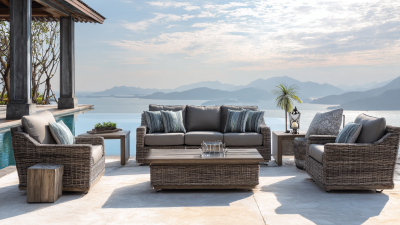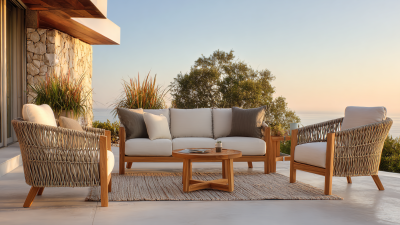Ultimate Guide to Choosing the Perfect Outdoor Deck Furniture for Your Space
When it comes to transforming your outdoor space into a relaxing oasis, choosing the perfect outdoor deck furniture is essential. With the wide variety of options available, it can be overwhelming to select pieces that not only complement your deck's aesthetic but also meet your comfort and functional needs. This ultimate guide will explore the top ten factors to consider when shopping for outdoor deck furniture, from materials and durability to style and layout. Whether you’re looking to create an inviting area for entertaining guests or a tranquil spot for enjoying your morning coffee, understanding these key elements will help you make informed decisions. Let’s dive into the world of outdoor deck furniture and discover how to curate a space that reflects your personal style while enhancing your outdoor experience.

Understanding Your Outdoor Space: Dimensions and Layout Considerations
When choosing outdoor deck furniture, understanding the dimensions and layout of your space is crucial. According to the Furniture Today report, nearly 70% of homeowners are dissatisfied with their outdoor spaces due to improper furniture sizing. This dissatisfaction often stems from oversized furniture that hinders movement or furniture that is too small for the available area, which leads to an unbalanced look. To avoid these pitfalls, measure your deck’s dimensions, including any obstacles like railings or built-in features, to create a harmonious flow.
Layout considerations also play a significant role in the overall functionality and aesthetics of your outdoor area. The American Society of Landscape Architects advises allocating at least 36 inches of walking space around furniture for easy navigation and comfort. When configuring your space, think about how you want to use it—whether for entertaining guests, lounging, or dining. By considering these factors, you can select the right pieces that not only enhance the beauty of your outdoor deck but also cater to your lifestyle needs, ensuring a practical and inviting atmosphere.
Choosing Weather-Resistant Materials: Wood, Metal, and Synthetic Options
When selecting outdoor deck furniture, one of the most critical considerations is the choice of materials, particularly those that can withstand the elements. According to a report from the American Home Furnishings Alliance, 70% of consumers prioritize weather resistance when purchasing outdoor furniture. Wood, metal, and synthetic materials each offer distinct advantages, depending on your local climate and maintenance preferences.

Wood, particularly teak and cedar, is known for its natural beauty and strength. Teak has a natural high oil content that helps it resist moisture, making it ideal for humid environments. The sustainability aspect is also significant, as responsibly sourced wood can offer an eco-friendly option. However, maintenance can be demanding, requiring regular sealing to prevent weather damage.
On the other hand, metals such as aluminum or stainless steel are gaining popularity due to their durability and minimal upkeep. A study by the International Casual Furnishings Association shows that aluminum furniture can last over 30 years, making it a long-term investment. For those seeking low maintenance, synthetic materials like HDPE (high-density polyethylene) mimic the look of wood while providing superior resistance to fading and cracking. Easing the burden of upkeep, synthetic options have seen increased adoption, with a reported 45% surge in demand according to Furniture Today’s market analysis. Choosing the right material ensures your outdoor space remains inviting and functional for years to come.
Evaluating Comfort: The Importance of Ergonomics in Outdoor Furniture
When it comes to selecting outdoor deck furniture, comfort is paramount, and understanding ergonomics can significantly enhance your experience. A well-designed piece of furniture not only looks great but also responds to the body's natural posture. According to the American Physical Therapy Association, an ergonomic seating arrangement can reduce the risk of musculoskeletal disorders and improve overall well-being. This is especially crucial for outdoor spaces where relaxation and leisure are priorities.
Research from the Home Furnishings Association indicates that over 70% of consumers prioritize comfort when purchasing outdoor furniture. Features such as seat depth, lumbar support, and adjustable components can make a substantial difference in the level of comfort provided. For instance, chairs with a seat height ranging from 17 to 19 inches are typically more accessible and promote better posture. Moreover, cushions designed with high-density foam can enhance comfort without sacrificing style. Investing in ergonomically sound furniture not only elevates the outdoor experience but also encourages longer, more enjoyable gatherings with family and friends.
Color and Style Trends: How to Match Furniture with Your Outdoor Aesthetics
When selecting outdoor deck furniture, aligning color and style with your existing outdoor aesthetics is crucial for creating a cohesive and inviting space. Start by observing the natural elements surrounding your deck, such as the greenery, landscaping, and architectural features of your home. Earthy tones like greens, browns, and beiges can seamlessly blend with nature, while vibrant hues such as teal or coral can add a pop of color that infuses energy into the environment. Incorporating textures through materials like wicker, metal, or wood also allows you to achieve a dynamic aesthetic that enhances the visual appeal of your outdoor area.

Trends in outdoor furniture design often lean toward minimalist styles with sleek lines and multifunctional pieces that are not only stylish but practical. Consider furniture made from weather-resistant materials that come in muted colors to convey a sophisticated look, or opt for bold statement pieces that serve as conversation starters. By ensuring that your furniture complements both the color palette and textures of your outdoor space, you create an atmosphere that invites relaxation and entertainment, perfectly tailored to your lifestyle.
Budgeting for Quality: Industry Data on Long-Term Value of Outdoor Furniture
When it comes to selecting outdoor deck furniture, understanding the long-term value is crucial for budgeting effectively. According to a recent report by the American Society of Landscape Architects, investing in high-quality outdoor furniture can yield returns exceeding 25% over several years. This long-lasting durability not only enhances your outdoor space but also reduces the need for frequent replacements, making it a financially sound decision.
Furthermore, the Furniture Today survey highlighted that consumers spend an average of 30% more on outdoor furniture that boasts weather-resistant materials. This initial investment translates to a longer lifespan, with products lasting 10-15 years compared to the average 5 years for lower-quality alternatives. By prioritizing quality over price, homeowners can enjoy their outdoor spaces without the worry of deterioration or the constant need for upgrades, ultimately leading to more savings in the long run.
Ultimate Guide to Choosing the Perfect Outdoor Deck Furniture for Your Space
This chart illustrates the average longevity of different outdoor furniture materials, presenting important data for budgeting decisions related to quality and long-term value.
INFORMATION CENTER
RESOURCES & MORE
INSPIRATION FOR YOU
© Copyright 1981 - 2025 | California Patio™ All Rights Reserved
© Copyright 1981 - 2025 | California Patio™ All Rights Reserved




